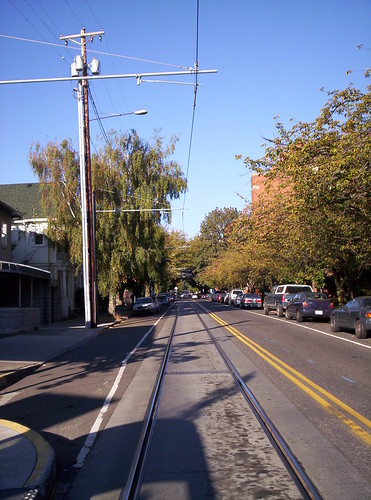City Paper article on streetcars and historic preservation
"Garage Banned: Can D.C.’s Public Transit Future Take a Cue from Its Past?" is worth reading.
However, the Trieschmann quote isn't really accurate:
“H Street NE started as a residential street,” says Laura Trieschmann of EHT Traceries, who co-authored a lengthy study of the city’s streetcar history. “As soon as the streetcar came, commerce came in.”
There wasn't much of anything on H St. or in the greater neighborhood before the streetcar was constructed, neither residents nor businesses. (Look at the plat books and the Boschke map from just before the Civil War to confirm.)
The streetcar (Columbia Horse Car Railway Company) was built by landowners (including Willard of Willard Hotel) who wanted to be able to sell property that they had bought on a speculative basis. They weren't successfully doing that without a streetcar, so they built it.
That was not uncommon in the DC area (and elsewhere across the country and in the UK, especially the history of railroad and transit service in Greater London). For example, Connecticut Ave. was built by the streetcar company as part of the franchise agreement. The streetcar company operating on that street was founded by the Newlands Company real estate development firm, to bring residents to Chevy Chase DC/MD.
I think in the 1880s (I can't remember and would have to consult the plat books) the H Street neighborhood was replatted into urban-sized (rowhouse-sized) lots. Previously, land ownership had been organized in relatively large lots not suitable for production housing construction.
I was at a presentation last night where the presenter inaccurately referred to all streetcar related housing development as "suburban." The H Street neighborhood was part of the L'Enfant City and the lot structure was reorganized to reflect its location within the city, as the city began to fill out over the course of the 19th Century.
wrt the CP article, the analogies between> sites (Western Bus Garage vs. the 14th Street Garage; Cardozo vs. Spingarn) and the implications for (re)development are intellectually inconsistent.
One could argue that "changing" the Cardozo site by adding an athletic field is a related act and within the context of the continued evolution of the site as a school, whereas adding a streetcar building to the Spingarn High School site is a fundamental and significant change in the land use context, one that is contrary.
But it's not inconsistent to make the point that a relatively undistinguished Western Bus Garage isn't worth designating, even if the site--and previous, now demolished, buildings--has served continuously as a site for transit service infrastructure.
Or, depending on how the Spingarn site is organized and subdivided, maybe the side lot isn't significantly part of the site's historicity and a streetcar building could justifiably be built there. In any case, from the standpoint of historic preservation, the questions are deserving of deeper consideration.
Hence the application for a landmark status--and as I have said before, city and federal laws required DDOT to do an evaluation of the potential impact of the streetcar, positive and negative, to historic resources, and mitigate potentially negative impacts.
The federal process is called "Section 106," named after the relevant section of the National Historic Preservation Act. In changes to the DC historic preservation laws a few years ago, a comparable local process was added to guide the actions of DC Government agencies, which frequently ignore their responsibilities to consider the impact of their actions on historic resources.

Streetcar wires in Nob Hill, Portland. In DC (and parts of Philadelphia), because there isn't an overhead wiring infrastructure, streetcars would be powered from relatively inconspicuous wires strung from street lights.
For the most part, I don't see any negative impacts from addition of the streetcars more generally to the city, even in the L'Enfant City where overhead wire infrastructure is normally banned--even the wires are relatively unobtrusive and the trade off for significantly more comfortable and quieter transit service is probably worth it--except for the possible siting of streetcar barns.
Frankly, I could go either way with a streetcar barn on the grounds of Spingarn--the City Paper article makes a good point about evolution of neighborhoods over long periods of time--but DDOT hasn't adequately addressed significant historic preservation related questions and put forth very good arguments thus far, and there are better and/or less obtrusive locations, even if those locations have other issues and DDOT chose instead for a seemingly easier course.
Labels: historic preservation, streetcars, transit design and engineering, transportation infrastructure, transportation planning



3 Comments:
The implementation of this will result good. Thanks to the officials.
Store Pickup Croydon Ikea Delivery Man Van Hire Flat Pack Assembly Croydon Ikea
Call or text 0 7 9 1 7 5 6 9 0 7 4
Ikea Croydon Delivery
Man and Van Hire Croydon Ikea Croydon Delivery Flatpack Furniture Collection Assembly
Man and Van Croydon Removals
Ikea Croydon Man With Van Hire
I do assemble ikea flatpack Bedrooms kitchens wardrobes sofas bookcases tables etc.
IKEA Furniture Assembly
I have My own tool box and lot of years experience in flat pack.
Call or text 0 7 9 1 7 5 6 9 0 7 4
Plus if you need to help with Painting your flat or house i can do on fix quote.
Ikea Wembley Delivery
Ikea Croydon Flatpack Furniture Collection Delivery Assembly Man and Van Croydon
I really appreciate your post and you explain each and every point very well.This has been a very significant blog indeed. I’ve acquired a lot of helpful information from your article. Thank you for sharing such relevant topic with us.We are proud of our self’s for offering a reliable and punctual Removals Service in and outer London, with highly experienced team of removal men prepared to work hard to satisfy our customers.
Man and Van Balham
Post a Comment
<< Home